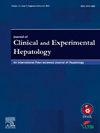在一组活检证实的原发性高BMI的MASLD患者中,无创评分对纤维化MASH的诊断准确性
IF 3.2
Q2 GASTROENTEROLOGY & HEPATOLOGY
Journal of Clinical and Experimental Hepatology
Pub Date : 2025-03-25
DOI:10.1016/j.jceh.2025.102556
引用次数: 0
摘要
目前,纤维化-4 (FIB-4)和非酒精性脂肪性肝病纤维化评分(NFS)被用于预测代谢功能障碍相关脂肪性肝病(MASLD)患者的纤维化和脂肪变性。最近,已经创建了纤维化非酒精性脂肪性肝炎(NASH)指数(FNI)和脂肪变性相关纤维化估计值(SAFE)。我们比较了这些无创评分系统在MASLD患者中的准确性。方法回顾性分析来自三级医疗保健系统的244例经活检证实的MASLD患者。通过计算95%置信区间的受试者工作特征(AUROC)曲线下面积、敏感性、特异性、阴性预测值(NPV)和阳性预测值(PPV)来确定评分表现。结果25例(10.3%)患者为纤维化代谢功能障碍相关脂肪性肝炎(MASH)。FNI评分在预测纤维化性MASH方面最好,AUROC为0.78,而NFS评分在预测纤维化性NASH方面最差,AUROC为0.60。在整个队列中,FNI为0.33,FIB-4为2.67,SAFE为100,NFS为0.675,ppv分别为17%,31%,17%和16%,npv分别为97%,92%,96%和91%。FIB4的特异性最高,为92%,NFS为86%,而FNI和SAFE评分的敏感性最高,分别为88%和80%。结论与其他评分系统相比,fni和SAFE评分对纤维化性MASH的诊断准确性更高。虽然肝活检仍然是金标准诊断方法,但非侵入性评分如FNI和SAFE评分可用于日常临床实践中评估纤维化MASH。本文章由计算机程序翻译,如有差异,请以英文原文为准。

Diagnostic Accuracy of Noninvasive Scores for Fibrotic MASH in a Cohort of Biopsy-proven MASLD Patients With Predominantly High BMI in the Primary Care Setting
Background
Currently, the Fibrosis-4 (FIB-4) and nonalcoholic fatty liver disease fibrosis score (NFS) are used to predict fibrosis and steatosis in patients with or at risk for metabolic dysfunction-associated steatotic liver disease (MASLD). More recently, the fibrotic nonalcoholic steatohepatitis (NASH) index (FNI) and steatosis-associated fibrosis estimator (SAFE) have been created. We have compared the accuracy of these noninvasive scoring systems in MASLD patients.
Methods
This is a retrospective analysis of 244 biopsy-proven MASLD patients from a tertiary health care system. Score performances were determined by calculating the area under the receiver operating characteristic (AUROC) curve with 95% confidence intervals, sensitivity, specificity, negative predictive value (NPV), and positive predictive value (PPV).
Results
About 25 (10.3%) patients had fibrotic metabolic dysfunction-associated steatohepatitis (MASH). The FNI score was best at predicting fibrotic MASH with an AUROC of 0.78, while NFS was the worst at predicting fibrotic NASH with an AUROC of 0.60. In the entire cohort, FNI of 0.33, FIB-4 of 2.67, SAFE >100, and NFS >0.675 had PPVs of 17%, 31%, 17%, and 16%, respectively, and NPVs of 97%, 92%, 96%, and 91%, respectively. Specificity was greatest for FIB4 at 92% and NFS at 86%, whereas the sensitivity was greatest for FNI and SAFE scores at 88% and 80%, respectively.
Conclusion
FNI and SAFE scores have superior diagnostic accuracy for fibrotic MASH compared to other scoring systems. While liver biopsy remains the gold standard diagnostic method, noninvasive scores like FNI, and SAFE scores can be used in everyday clinical practice to assess for fibrotic MASH.
求助全文
通过发布文献求助,成功后即可免费获取论文全文。
去求助
来源期刊

Journal of Clinical and Experimental Hepatology
GASTROENTEROLOGY & HEPATOLOGY-
CiteScore
4.90
自引率
16.70%
发文量
537
审稿时长
64 days
 求助内容:
求助内容: 应助结果提醒方式:
应助结果提醒方式:


